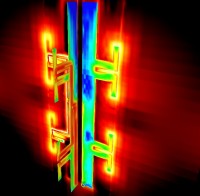ET4288 Applied electromagnetic analysis in wireless, microwave and radar engineering
EM simulation methods offer powerful tools for solving complex electromagnetic coupling, radiation and scattering problems, as encountered in the field of telecommunications, microwave, and radar engineering. Within the course on examples of different typical problems like transmission lines, microwave filters, antennas, and Radar Cross Section of targets all basics physical phenomena of EM wave interaction with objects will be analyzed and characterized. The analysis will be done in frequency as well as in the time domain. The advantages and disadvantages of time-domain and frequency-domain methods will be compared. The course will finish with an overview of basic recommendations regarding the choice of appropriate computational methods for different problems of wireless, microwave, and radar engineering. At the supervised laboratory work, commercial simulation tools are used for simulation of five practical problems of wireless, microwave, and radar engineering.
The course consists of three major parts. In Part 1 the applied electromagnetics as a subject will be introduced, the scope of the problems and typical approaches will be considered. The role of applied electromagnetics in wireless, microwave, and radar engineering will be discussed. A general approach to the solution of applied electromagnetics problems is presented and discussed in detail.
Part 2 of the course is dedicated to frequency domain simulations. Based on a simple problem of electromagnetic wave interaction with a thin wire all basics radiation phenomena will be analyzed and characterized. The problem will be treated via the method of moments. All the essential features of the method of moments will be discussed in detail. Simulation results will be verified against experimental ones. Following this, students will be introduced to the commercial program FEKO. Various structures will be modeled using FEKO, including simple 2D structures (microstrip filters and patch antennas) as well as more complex 3D scatterers (sphere). Specific issues for EM wave interaction with 2D and 3D structures will be discussed. Finally, computational limitations of frequency-domain methods will be discussed. The advantages and disadvantages of time-domain and frequency-domain methods will be compared.
In Part 3 wideband (time-domain) simulations will be discussed. On the example of a one-dimensional transmission line, basic time-domain phenomena (such as dispersion, matching, stability) will be analyzed. The time-domain simulation will be performed using the Finite Difference Time Domain (FDTD) method. The aim of this is to develop a basic appreciation of the FDTD method, as well as reinforce concepts of transforming between time and frequency domains. The use of time-domain simulation for ultrawideband systems will be emphasized throughout. Finally, computational aspects of FDTD such as numerical dispersion, absorbing boundary conditions, and numerical complexity will be discussed.
The course will finish with an overview of basic recommendation regarding the choice of an appropriate computational method for different problems of wireless, microwave and radar engineering.
The lectures are supported by supervised laboratory work at which commercial simulation tools are used for simulation of five practical problems of wireless, microwave, and radar engineering.
The aim of this course is twofold: to introduce MSc students to electromagnetic problems encountered in the microwave, telecommunications, and radar engineering; and to teach students how to use available EM simulators for the analysis and design of microwave circuits, wireless and radar systems. Students will learn the basic properties and limitations of different computational methods realized in different EM simulators.
Teachers
prof.dr. Alexander Yarovoy (MS3)
microwave systems, radar
Last modified: 2023-11-03

Details
| Credits: | 4 EC |
|---|---|
| Period: | 0/0/0/0/6 (not running) |
| Contact: | Alexander Yarovoy |